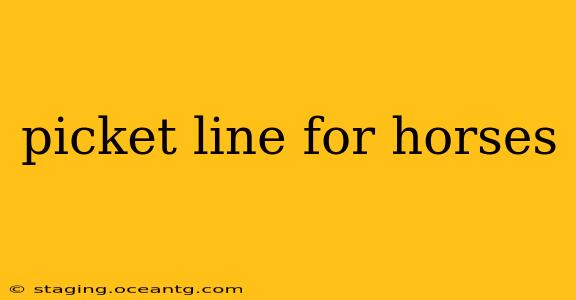The image of a picket line conjures up scenes of human protestors, but what about our equine companions? While not a common sight, the concept of a "picket line for horses" can refer to several situations where horses are strategically positioned or controlled in a linear formation, often for protest or demonstration. This article delves into the potential meanings and implications of this phrase, addressing safety concerns and exploring different contexts.
What Does a "Picket Line for Horses" Mean?
The term "picket line for horses" isn't a standardized term like its human counterpart. Its meaning depends heavily on the context. It could describe several scenarios:
-
Symbolic Protests: Horses could be positioned along a route to symbolize a protest related to equestrian issues, animal welfare, or land use. This wouldn't involve active blocking or disruption, but rather a visual statement.
-
Controlled Movement: In situations requiring the organized movement of a large number of horses, such as a parade or a trail ride, a "picket line" could refer to the controlled linear arrangement of the animals for safety and management. This ensures order and prevents stampedes or collisions.
-
Protecting Livestock: In some instances, horses might be used to passively protect other livestock from encroachment or threat. While not strictly a protest, the linear positioning resembles a picket line.
It's crucial to remember that any situation involving a large number of horses necessitates careful planning and experienced handlers to prioritize safety for both the animals and the people involved.
Safety Concerns Related to Horse Picket Lines (or Similar Formations)
Regardless of the intention, any arrangement of horses in a linear formation requires careful consideration of several safety factors:
-
Space and Spacing: Adequate spacing between horses is paramount to prevent kicking, biting, or accidental collisions. The temperament and compatibility of individual horses must be assessed.
-
Experienced Handlers: Experienced and knowledgeable handlers are essential to manage the animals effectively. Sudden movements, loud noises, or unfamiliar stimuli could easily spook the horses, leading to dangerous situations.
-
Environmental Considerations: The environment itself needs consideration; is the ground level and safe? Are there potential hazards like traffic, uneven terrain, or obstacles that could lead to accidents?
-
Public Safety: If the "picket line" involves a public space, measures must be in place to ensure public safety and prevent accidents involving pedestrians or vehicles.
Are There Specific Ethical Concerns When Using Horses in Demonstrations?
Yes, ethical considerations are crucial when employing horses in any demonstration or protest. The well-being of the animals must be the top priority. This includes:
-
Stress Levels: Horses can experience stress from crowds, loud noises, and unfamiliar situations. Ensuring minimal stress is paramount.
-
Suitable Animals: Only calm, well-trained horses should be used, and their suitability should be assessed beforehand.
-
Veterinary Care: Access to veterinary care should be readily available in case of any injuries or health issues.
What are the potential legal implications of using horses in a protest or demonstration?
The legal implications of using horses in protests or demonstrations vary depending on location and specific circumstances. Local ordinances and regulations regarding public assemblies, animal welfare, and road closures must be adhered to. Always consult local authorities before planning any such event involving animals.
What are some examples of successful (or unsuccessful) uses of horses in protests or demonstrations? (if any exist)
While a "picket line for horses" is not a commonly established practice, historical and contemporary examples of horses participating in demonstrations or protests are rarely reported in detail in accessible sources. The focus on safety and animal welfare would invariably dictate the style and implementation of any such endeavor.
This article aims to explore the potential interpretations of the concept, rather than providing examples of actual events. Further research on specific historical or contemporary cases would be needed to provide detailed examples.
In conclusion, while the concept of a "picket line for horses" is not a widely established practice, understanding the safety, ethical, and legal considerations is crucial when using horses in any public demonstration or event. Prioritizing animal welfare should always be paramount.
